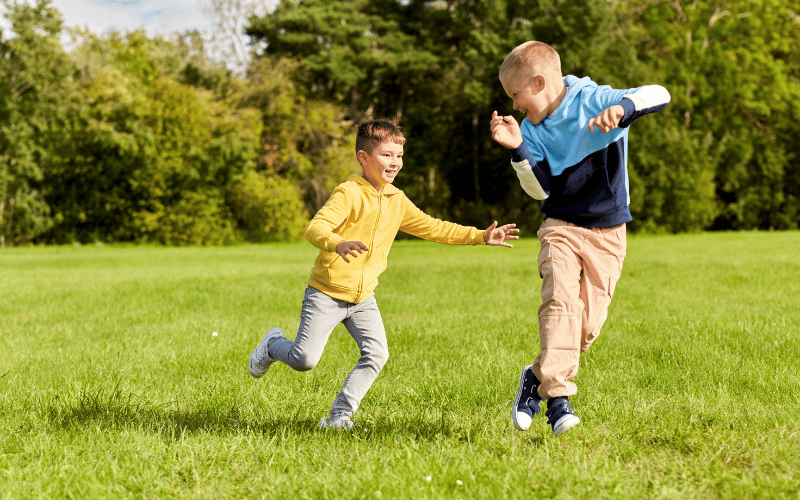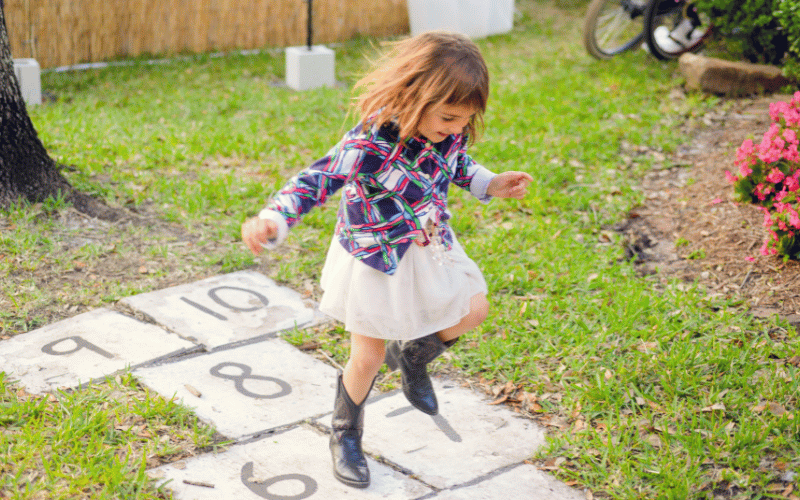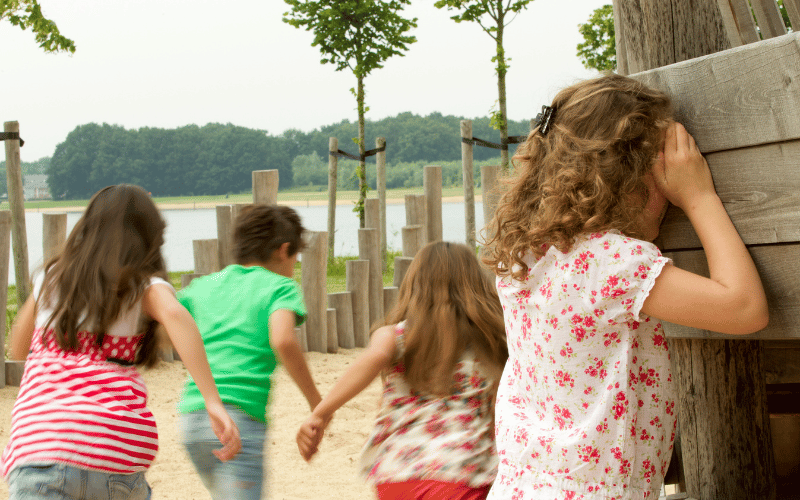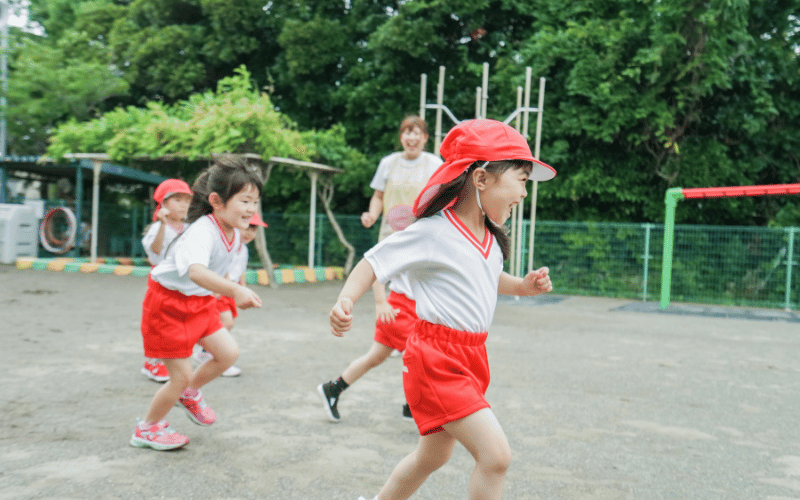Outdoor games bring excitement, physical activity, and a chance to connect with nature. Playing outside offers numerous benefits, from boosting physical health to improving mental well-being. For those seeking fun with a friend, 2-player games provide the perfect mix of competition and collaboration. Selecting the right game ensures everyone stays engaged and enjoys the experience to the fullest.
Table of Contents
ToggleClassic Outdoor Games for Kids
Outdoor games have been a cherished part of childhood for generations, offering endless fun while helping kids grow physically, socially, and mentally. Here are three timeless games that continue to delight children, each with its own unique appeal and benefits.
Tag: A Timeless Favorite
Tag is a high-energy game that never loses its charm, bringing laughter and excitement to any outdoor space. In this classic game, one player is “it” and chases others, trying to tag them by touch. Once tagged, the roles switch, and the new “it” continues the chase.
To make the game safe and enjoyable, play in a well-defined area with soft surfaces like grass or rubber mulch to cushion falls. Use cones, painted lines, or natural features like trees to mark boundaries. For added fun, try variations like Freeze Tag, where tagged players must freeze until another player frees them, or Blob Tag, where the “it” player grows their team by tagging others.
Tag is more than just a game—it’s a workout in disguise, helping kids build agility, speed, and social skills. Its simplicity, adaptability, and ability to spark teamwork and strategy make it a favorite for players of all ages.

Learn More
Hopscotch: Jumping Fun
Hopscotch is a classic game that blends physical activity with creativity, making it a favorite for kids of all ages. To set up, create a hopscotch grid using chalk on pavement, tape indoors, or weather-resistant materials like thermoplastic markings. For younger children, use smaller squares to match their stride, while older kids can enjoy larger, more challenging layouts. Add colorful markers like beanbags or flat stones to make the game more engaging. You can even encourage kids to design their own patterns or include numbers and shapes for an educational twist.

How to Play Hopscotch
Hopscotch is easy to play and helps kids practice jumping, balancing, and counting. Start by drawing or setting up a hopscotch grid and gathering a small object to throw, such as a stone, beanbag, or playdough.
The game begins with one player tossing their object onto the first square (number 1). The goal is to hop and jump through the grid, skipping the square with the object. For example, if the object lands on square 1, the player hops over it and continues through the rest of the grid. If they lose balance, step on the wrong square, or land on the square with the object, they must try again on their next turn.
When a player successfully completes the grid without mistakes, they “win” that number and move on to the next one (number 2). The game continues until someone reaches the last number, usually 10. The first player to complete all the numbers wins!
Hopscotch is more than just a game—it’s a fun way for kids to improve coordination, balance, and counting skills while learning to take turns and play fairly.
Hide and Seek: The Ultimate Game of Stealth
Hide and Seek is a timeless game that turns any outdoor space into an exciting world of adventure and discovery. To create the perfect play area, include a mix of open spaces and creative hiding spots, such as tunnels, climbing structures, or large shrubs. Safety should always come first—use equipment with rounded edges, non-toxic finishes, and sturdy construction. Set clear boundaries and rules, like avoiding off-limits areas and ensuring all players are visible at the end of each round, to keep the game safe and enjoyable. For an extra layer of fun, introduce themes like “Treasure Hunt” or “Animal Safari” to spark imagination. This game not only entertains but also sharpens problem-solving skills, spatial awareness, and teamwork.

How to Play Hide and Seek
Hide and Seek is simple to play and full of excitement. One player is chosen as the “seeker,” while the others hide. The seeker closes their eyes and counts to a set number, like 20, while the other players find hiding spots within the agreed boundaries. Once the counting is done, the seeker begins searching for the hidden players.
To make the game more engaging, choose a play area with a mix of open spaces and creative hiding spots, such as behind trees, inside tunnels, or around climbing structures. Clear rules are essential—players should stay within the boundaries and avoid unsafe areas. Adding themes, like pretending to be explorers on a treasure hunt or animals hiding in the wild, can make the game even more imaginative and fun.
The game continues until the seeker finds all the hidden players. Hide and Seek is more than just a game—it’s a fun way for kids to develop problem-solving skills, improve spatial awareness, and learn teamwork while enjoying endless outdoor adventures.
2 Player Game To Play Outside Playground: Classic Outdoor Games for Kids
Two-player games are a fantastic way for kids to bond, compete, and have fun in a playground setting. These games are simple to set up, require minimal equipment, and provide hours of entertainment while encouraging physical activity, teamwork, and skill-building.
Simon Says: The Game of Listening
Simon Says is a classic game that sharpens listening skills, quick thinking, and the ability to follow instructions. In this two-player version, one child takes on the role of “Simon,” giving commands that start with the phrase “Simon says,” such as “Simon says touch your toes” or “Simon says hop on one foot.” The other player must carefully follow only the commands that include “Simon says.” If Simon gives a command without saying “Simon says” (e.g., “Clap your hands”) and the other player follows it, they lose that round.
To make the game more dynamic in a playground setting, incorporate physical actions like running to a specific spot, climbing a structure, or balancing on one foot on a beam. Players can take turns being Simon, and the game can be made more challenging by speeding up the commands or adding complex sequences. This game not only entertains but also helps kids improve focus, coordination, and their ability to think on their feet.
Spud: A Game of Strategy and Agility
Spud is an exciting game that combines strategy, agility, and quick reflexes, making it perfect for two players in a playground. To play, assign each player a number (e.g., Player 1 and Player 2). One player starts by tossing a soft ball into the air while calling out the other player’s number. The player whose number is called must catch the ball as quickly as possible while the first player runs away.
Once the ball is caught, the player holding it yells “Spud” and takes three large steps toward the other player. They then gently throw the ball, aiming to tag the other player. If the throw misses, the game resets, and the roles switch. If the throw lands, the tagged player earns a letter in the word “SPUD.” The first player to spell out “SPUD” loses the game.
For safety, use a lightweight, soft ball and play in an open area free of obstacles. Spud encourages quick decision-making, hand-eye coordination, and strategic thinking, making it a playground favorite.
Jump Rope Challenges: A Test of Coordination and Endurance
Jump rope is a versatile and engaging two-player game that combines physical activity with friendly competition. In this version, one player swings the rope while the other jumps, counting how many successful jumps they can complete in a row. Players can take turns holding the rope and jumping, competing to see who can achieve the highest count without tripping.
To add variety, players can try different jumping styles, such as double jumps, alternating feet, or crisscrossing their arms. For an extra challenge, set a timer to see who can jump the longest or create a sequence of moves that the other player must copy.
If a long rope is available, both players can jump together, working on their timing and rhythm to stay in sync. Jump rope is not only fun but also helps improve coordination, endurance, and rhythm, making it a fantastic choice for playground play.
Incorporating Board Games Outdoors
Bringing board games outside adds a fresh twist to traditional gameplay, combining the fun of strategy and competition with the benefits of fresh air and open spaces. With a few adjustments, you can transform classic board games into outdoor-friendly activities that engage players of all ages.
Setting Up Outdoor Board Games
To set up board games outdoors, start by choosing a flat, stable surface like a picnic table, patio, or even a large wooden board placed on the ground. Use weighted game pieces or magnetic boards to prevent wind from disrupting the game. For added comfort, provide shade with umbrellas or canopies and ensure players have enough seating. If you’re playing on grass, consider using a waterproof mat or tarp to protect the game setup. Lighting is also essential for evening play—string lights or portable lanterns can create a cozy atmosphere while keeping the game visible.
Popular Board Games for Outdoor Play
Certain board games adapt well to outdoor settings, offering fun and simplicity. Giant versions of games like Chess, Checkers, or Jenga are perfect for lawns and patios, adding a physical element to the gameplay. Card games like Uno or Go Fish work well with waterproof or laminated cards, ensuring durability. For strategy enthusiasts, games like Catan or Ticket to Ride can be played outdoors with a few modifications, such as securing the board and pieces with adhesive putty. These games not only entertain but also encourage critical thinking and social interaction, making them ideal for outdoor gatherings.
Creating Your Own Outdoor Board Game
Designing your own outdoor board game allows for creativity and customization. Start by selecting a theme, such as a treasure hunt or obstacle course, and create a large-scale game board using chalk, paint, or fabric. Use household items like cones, buckets, or beanbags as game pieces, and incorporate physical challenges or trivia questions to keep players engaged. For example, a life-sized Snakes and Ladders game can use ropes for snakes and small ladders for climbing. Ensure the materials are weather-resistant and safe for all participants. This approach not only entertains but also fosters teamwork and imagination, making it a memorable outdoor activity.
Frequently Asked Questions
Q: What are some fun group activities for two players in the playground?
A: Two players can enjoy games like hopscotch, tag, and jump rope in the playground. They can take turns creating hopscotch patterns with chalk or play a unique version of musical chairs designed for two players. Each activity promotes physical movement and teamwork while keeping the fun alive.
Q: How do you play tag in the playground with two players?
A: Playing tag with two players is easy and exciting. One player starts as “it” and chases the other. The goal is for “it” to tag the other player, at which point the roles switch. The game continues as long as both players want to play and works best in an open area.
Q: Can you explain the hopscotch game for two players?
A: In hopscotch for two players, each takes turns tossing a marker onto a chalk-drawn hopscotch grid. The player hops on one foot to retrieve the marker without stepping on the lines. If successful, they can continue or let the other player take their turn. The game ends when one player completes the grid without errors.
Q: What is the objective of playing musical chairs with two players?
A: In a two-player version of musical chairs, the goal is to grab the single chair when the music stops. Both players circle the chair, and the one who sits down first wins the round. Players can switch roles and repeat the game for added fun.
Q: How can players enjoy truth or dare in an outdoor playground?
A: Players can enjoy truth or dare outdoors by taking turns asking each other creative truth questions or fun dares involving the playground. This game sparks laughter and creativity, making it a great choice for kids of all ages.
Q: What are the rules for playing hide and seek with two players?
A: In two-player hide and seek, one player counts to a set number while the other hides. The seeker then searches for the hidden player. Once found, they switch roles. To keep the game safe and organized, players should agree on clear boundaries within the playground.
Q: How do you play spud in a playground setting?
A: In spud, one player throws a ball while the other tries to catch it. After catching, the player yells “spud” and takes a set number of steps toward the other player before attempting to tag them with the ball. This game works well in open playground spaces and encourages quick thinking and agility.
Q: What is a great game for two players using a jump rope?
A: A fun jump rope game for two players involves seeing how many jumps they can complete together. One player swings the rope while the other jumps, and they can switch roles or try different jumping styles. This game improves coordination and keeps players active.
Conclusion
In conclusion, classic outdoor games like Tag, Hopscotch, and Hide and Seek continue to bring joy while promoting physical and social development. Encouraging outdoor play helps children build essential skills, stay active, and connect with others. Two-player games add a layer of bonding and strategy, making them a valuable addition to any outdoor activity lineup.






